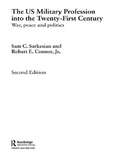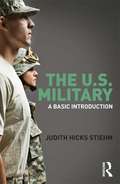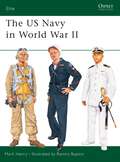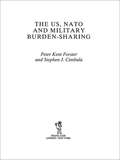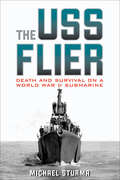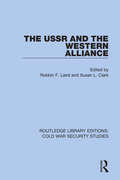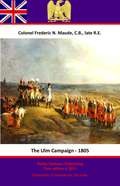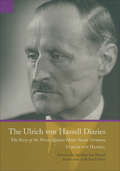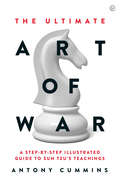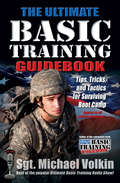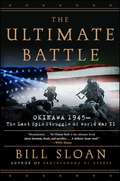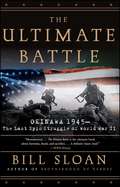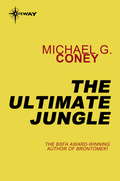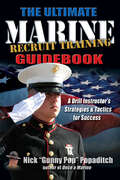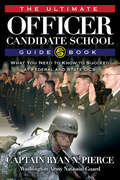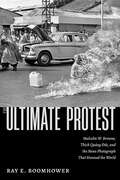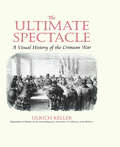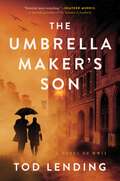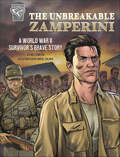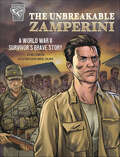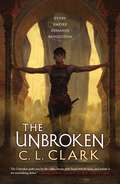- Table View
- List View
The US Military Profession into the 21st Century: War, Peace and Politics (Cass Military Studies)
by Sam Sarkesian Robert ConnorThis brand new edition of The US Military Profession into the Twenty-First Century re-examines the challenges faced by the military profession in the aftermath of the international terrorist attack on the United States on September 11, 2001. While many of the issues facing the military profession examined in the first edition remain, the 'new war' and international terrorism have compounded the challenges. The US military must respond to the changed domestic and strategic landscapes without diminishing its primary function—a function that now many see that goes beyond success on the battlefield. Not only has this complicated the problem of reconciling the military professional ethos and raison d’etre with civilian control in a democracy, it challenges traditional military professionalism. This book also studies the notion of a US military stretched thin and relying more heavily on the US Federal Reserves and National Guard. These developments make the US military profession increasingly linked to public attitudes and political perspectives. In sum, the challenge faced by the US military profession can be termed a dual dilemma. It must respond effectively to the twenty-first century strategic landscape while undergoing the revolution in military affairs and transformation. At the same time, the military profession must insure that it remains compatible with civilian cultures and the US political-social system without eroding its primary function. This is an invaluable book for all students with an interest in the US Military, and of strategic studies and military history in general.
The US Military in Hawai'i
by Brian IrelandAn examination of how the US military in Hawaii is depicted by museum curators, memorial builders, film makers, and newspaper reporters. These mediums convey information, and engage their audiences, in ways that, together, form a powerful advocacy for the benefits of militarism in the islands.
The US Military: A Basic Introduction (Cass Military Studies)
by Judith Hicks StiehmThis book provides a basic guide to the US military and will raise questions for further discussion by students and other curious readers. The US Military provides an accessible starting-point for those with a limited knowledge of this institution. Covering a wide range of subject matter, and ending with an extensive list of suggested resources to aid individual study and research, the text is divided into the following chapters: The A, B, Cs Strategy and Doctrine The Military in Action Weapons and Capabilities The Budget This book will be of great interest to students of the US military, US politics, defense studies, and war and conflict studies, and will also be of relevance to journalists, NGO staff and diplomats.
The US Navy in World War II
by Ramiro Bujeiro Mark HenryOsprey's examination of the United States Navy during World War II (1939-1945). In 1941 the US Navy had 17 battleships - of which eight would be knocked out on the first day of the war - four aircraft carriers, and about 340,000 men including reservists. Pearl Harbor so weakened it that it was unable to prevent the Japanese capture of the Philippines and a vast sweep of Pacific islands. By 1945 it was the strongest navy the world had ever seen, with nearly 100 carriers, 41,000 aircraft and 3.3 million men; the unrivalled master of air-sea and amphibious operations, it was poised to invade Japan's home islands after reducing her fleet to scrap and her Pacific empire to impotence and starvation. This extraordinary story is illustrated here with dramatic photos, and nine meticulous colour plates showing a wide range of USN uniforms.
The US, NATO and Military Burden-Sharing (Contemporary Security Studies)
by Peter Forster Stephen J. CimbalaThis study establishes that the political, economic and military-technological changes that transform the international system also alter the way in which a state views its and others' responsibilities and burdens for responding to international crises. It assesses the distribution of the costs of raising and supporting arms of service, the risks of deploying them overseas and using them in combat or peace operations, and the extent to which members have a responsibility for maintaining international order in the context of three instances of multinational military intervention: the Multinational Force deployment in Lebanon in 1982-83; the first Persian Gulf War in 1990-91; and the UN and NATO intervention in Bosnia-Herzegovina.
The USS Flier: Death and Survival on a World War II Submarine
by Michael SturmaThe realities of WWII underwater warfare come to life in this chronicle of a submarine sunk in the Philippines—and the remarkable sailors who survived.The fate of the USS Flier is one of the most astonishing stories of the Second World War. On August 13, 1944, the submarine struck a mine and sank to the bottom of the Sulu Sea in less than one minute, leaving only fourteen of its crew of eighty-six hands alive. After enduring eighteen hours in the water, eight remaining survivors swam to a remote island controlled by the Japanese. Deep behind enemy lines and without food or drinking water, the crewmen realized that their struggle for survival had just begun.Those eight sailors became the first Americans of the Pacific war to escape from a sunken submarine and return safely to the United States. Their story of persistence and survival has all the elements of a classic World War II tale: sudden disaster, physical deprivation, a ruthless enemy, and a dramatic escape from behind enemy lines. In The USS Flier, noted historian Michael Sturma vividly recounts a harrowing story of brave men who lived to return to the service of their country.
The USSR and the Western Alliance (Routledge Library Editions: Cold War Security Studies #60)
by Robbin F. Laird; Susan L. ClarkThis book, first published in 1990, examines the relationship between the Soviet Union and the Western Alliance at a time of great changes. Experts on a range of topics analyse the relationship from both the Soviet perspective (the impact of Gorbachev, and the role of Eastern Europe), and from the standpoint of the nations of the West including France, Great Britain and West Germany). Also included is a discussion of the role of the northern flank in Soviet nuclear-free proposals. The book concludes with an assessment of the challenges posed by the changing Soviet perspective, and the opportunities that these present for the Western Alliance.
The Ulm Campaign - 1805 (The Special Campaigns Series #12)
by Pickle Partners Publishing Colonel Frederic Natusch Maude, C.B., late R.E.This ebook is purpose built and is proof-read and re-type set from the original to provide an outstanding experience of reflowing text for an ebook reader. Text taken, whole and complete, from the edition published in 1904, London, by John Lane, The Bodley Head. Original - 452 pages. Portraits and Illustrations - 8 included MAPS - due to their size have not been included [4 A3] Linked TOC
The Ulrich von Hassell Diaries: The Story of the Forces Against Hitler Inside Germany
by Ulrich von HassellThe memoir of a man who was a member of the Nazi Party—and ultimately became a martyr to the resistance. Ulrich von Hassell began working for the German Foreign Office in 1909, then aged twenty-eight. Two years later, he married Ilse von Tirpitz, the daughter of Grand Adm. Alfred von Tirpitz. After being wounded in the First Battle of the Marne, he worked as the admiral&’s advisor and private secretary. Hassell joined the Nazi Party in 1933, but strongly opposed the Anti-Comintern Pact (1937) and was sacked by Joachim von Ribbentrop from his posting in Rome. After Poland was attacked, he led a delegation to allay European fears of further German aggression. He participated in plans to overthrow Hitler, acting as a liaison between Carl Goerdeler, Ludwig Beck, and the Kreisau Circle, and attempted to recruit Franz Halder, Friedrich Fromm, and Erwin Rommel to the idea of a military coup followed by a negotiated peace. He also used his position on the Central European Economic Council to discuss with Allied officials what could follow a coup d&’état in Germany. Finally, he played the role of a principal civilian advisor in the July Plot of 1944—and was executed after a two-day trial. Without doubt, Ulrich von Hassell was one of the most important members of the German Resistance: this is the first complete edition of his wartime memoir with new material from his grandson, Agostino von Hassell.
The Ultimate Art of War: A Step-by-Step Illustrated Guide to Sun Tzu's Teachings
by Antony CumminsThis is the most accessible edition of Art of War ever produced, with the text broken down into digestible individual lessons, unique teaching illustrations to clarify the text, and step-by-step commentary that draws on the full range of recent translations and ancient commentators.Composed in the 5th century BC, Sun Tzu's Art of War is the earliest-known treatise on military strategy, and is still hugely popular around the world for its perceptive tactical advice to commanders on how to win at war with minimal bloodshed. Aimed at all those who want to study the text in depth, this is the first step-by-step guide to the famous treatise, breaking down the 13 chapters of the original into 200 easily digested lessons, from 'do not press a desperate enemy' to 'control your troops through bond of loyalty' to 'when you are weak, beware attack', all accompanied by comprehensive commentary and clarified with around 250 illustrations. Making the lessons even more memorable and easy to understand, the black/red illustrations include strategic diagrams, evocative line drawings and beautiful calligraphy. This ultimate guide to Art of War includes the classic 1910 translation by Lionel Giles and commentary that takes into account all academic interpretations of the text, highlighting differences between modern translations as well as the perspectives of historical Chinese commentators. No other edition compares and contrasts the viewpoints of different contemporary translators, or explains exactly what each section of this often enigmatic text actually means.
The Ultimate Basic Training Guidebook: Tips, Tricks, and Tactics for Surviving Boot Camp
by Michael VolkinAs anyone who has undergone the transition from civilian to soldier will tell you, basic training is a lot tougher and more challenging than any recruit can imagine. Michael Volkin discovered that fact soon after 9-11, when his personal vow to serve my country convinced him to enlist in the US Army. As Volkin quickly discovered, he was utterly unprepared for the new world of the military, a completely different environment full of unknown exercises and acronyms, where cant eat or talk without permission. Volkin began taking notes on everything and anything with the hope that no one else would have to go through basic training like I did completely unarmed with knowledge that would have eased my transition into the military and allowed me to be more successful.During Operation Enduring/Iraqi Freedom, Volkin organized his notes, interviewed hundreds of other soldiers, and began to write. The result is The Ultimate Basic Training Guidebook, a unique and utterly indispensable guide to successfully coping with and thriving in todays military. The Ultimate Basic Training Guidebook is a comprehensive, practical, and easy-to-follow survival guide written specifically for every new or prospective recruit about to enter any branch of the armed forces. Volkins book offers step-by-step instructions and solutions, including helpful charts and graphics, for how to prepare both physically and mentally for boot camp. It includes a special eight-week fitness program specifically designed to improve your fitness test scores, specific study guides, an instructional How tochapter, a list of what to bring (and not to bring) to basic training, tips for success, and much more. The Ultimate Basic Training Guidebook was written by a soldier for men and women who want to become soldiers. No one should enter boot camp without having read this book.
The Ultimate Battle
by Bill SloanThe Ultimate Battle is the full story of the last great clash of World War II as it has never before been told. With the same "grunt's-eye-view" narrative style that distinguished his Brotherhood of Heroes (on the Battle of Peleliu), Bill Sloan presents a gripping and uniquely personal saga of heroism and sacrifice in which at least 115,000 soldiers, sailors, and airmen from both sides were killed, as were nearly 150,000 civilians caught in the crossfire or encouraged to commit suicide by Japanese troops. It is a story set against a panorama of more than 1,500 American ships, nearly two thousand Japanese kamikazes sworn to sink those ships, and two huge armies locked in a no-quarter struggle to the death -- the 541,000 GIs and Marines of the U.S. Tenth Army, and Japan's 110,000-man 32nd Army. Woven into the broader narrative, in Band of Brothers style, are the personal stories of men who endured this epic battle and were interviewed by the author. In many cases, their experiences are told here in print for the first time. A few days after Japanese defenders surprised American assault troops by allowing them to land virtually unopposed on April 1, 1945, scouts of the 96th Division stumbled onto the outerworks of formidable Japanese defenses near Kakazu Ridge, where fierce fighting erupted. It would continue without respite for nearly three months as American forces used every weapon and strategy at their disposal to break through three cunningly designed Japanese lines of defense, each anchored by commanding high ground, intricate underground installations, and massed artillery. When one line was about to be breached, the Japanese would slip away to the next one, forcing the Americans to repeat the same exhausting and deadly "corkscrew and blowtorch" assaults all over again. Much of the action in The Ultimate Battle unfolds among men pinned down under relentless fire on disputed hillsides, in the ruins of shell-blasted villages, and inside stricken tanks and armored cars. Sloan also takes readers aboard flaming ships and into the cockpits of night-fighter aircraft to capture the horror and heroism of men and vessels besieged by kamikazes. When the battle was over, most of the GIs, Marines, and sailors who survived it were too worn out to celebrate. More than 49,000 of their comrades had been killed or wounded, and they knew that the even more brutal invasion of Japan's home islands loomed just ahead. But as Sloan makes clear, the slaughter at Okinawa helped to convince President Truman to use the atomic bomb against Japanese cities in the hope of shortening the war and averting a far more horrific loss of life. The Ultimate Battle is a searing and unforgettable recreation of the Okinawa campaign as it was experienced by men who were there. It is filled with fresh insights that only those men can provide.
The Ultimate Battle, Okinawa 1945: The Last Epic Struggle of World War II
by Bill SloanThe Ultimate Battle is the full story of the last great clash of World War II as it has never before been told. With the same "grunt's-eye-view" narrative style that distinguished his Brotherhood of Heroes (on the Battle of Peleliu), Bill Sloan presents a gripping and uniquely personal saga of heroism and sacrifice in which at least 115,000 soldiers, sailors, and airmen from both sides were killed, as were nearly 150,000 civilians caught in the crossfire or encouraged to commit suicide by Japanese troops. It is a story set against a panorama of more than 1,500 American ships, nearly two thousand Japanese kamikazes sworn to sink those ships, and two huge armies locked in a no-quarter struggle to the death -- the 541,000 GIs and Marines of the U. S. Tenth Army, and Japan's 110,000-man 32nd Army. Woven into the broader narrative, in Band of Brothers style, are the personal stories of men who endured this epic battle and were interviewed by the author. In many cases, their experiences are told here in print for the first time. A few days after Japanese defenders surprised American assault troops by allowing them to land virtually unopposed on April 1, 1945, scouts of the 96th Division stumbled onto the outerworks of formidable Japanese defenses near Kakazu Ridge, where fierce fighting erupted. It would continue without respite for nearly three months as American forces used every weapon and strategy at their disposal to break through three cunningly designed Japanese lines of defense, each anchored by commanding high ground, intricate underground installations, and massed artillery. When one line was about to be breached, the Japanese would slip away to the next one, forcing the Americans to repeat the same exhausting and deadly "corkscrew and blowtorch" assaults all over again. Much of the action in The Ultimate Battle unfolds among men pinned down under relentless fire on disputed hillsides, in the ruins of shell-blasted villages, and inside stricken tanks and armored cars. Sloan also takes readers aboard flaming ships and into the cockpits of night-fighter aircraft to capture the horror and heroism of men and vessels besieged by kamikazes. When the battle was over, most of the GIs, Marines, and sailors who survived it were too worn out to celebrate. More than 49,000 of their comrades had been killed or wounded, and they knew that the even more brutal invasion of Japan's home islands loomed just ahead. But as Sloan makes clear, the slaughter at Okinawa helped to convince President Truman to use the atomic bomb against Japanese cities in the hope of shortening the war and averting a far more horrific loss of life. The Ultimate Battle is a searing and unforgettable recreation of the Okinawa campaign as it was experienced by men who were there. It is filled with fresh insights that only those men can provide.
The Ultimate Guide to the Declaration of Independence
by David Hirsch Dan Van HaftenDrafted by Thomas Jefferson, the logical force of the Declaration facilitated the survival of a nation. The Ultimate Guide to the Declaration of Independence explains the document more thoroughly than any book previously published. With the aid of colorized step-by-step diagrams, the authors deconstruct Jefferson’s masterpiece into the six elements of a proposition to demonstrate how the scientific method is basic to its structure. David Hirsch and Dan Van Haften, the critically acclaimed authors of Abraham Lincoln and the Structure of Reason, are the first to discover and demonstrate Jefferson’s use of the six elements of a proposition. Hirsch and Van Haften diagram and explain how six-element structure helped Jefferson organize and compose the Declaration. The result is a much deeper and richer understanding and appreciation of the Declaration that was not previously possible. This concise full-color examination of one of our nation’s most treasured and important documents is perfect for all ages and especially for those interested in history, the use of language, and logic.
The Ultimate Guide to the Gettysburg Address
by David Hirsch Dan Van HaftenAbraham Lincoln’s November 19, 1863, Gettysburg Address is generally recognized as one of the greatest leadership speeches ever written. The Ultimate Guide to the Gettysburg Address explains the 272-word speech more thoroughly than any book previously published. With the aid of colorized step-by-step diagrams, the authors deconstruct the speech into its basic elements and demonstrate how the scientific method is basic to the structure of the Gettysburg Address. Lincoln’s fascination with geometry is well documented. Authors David Hirsch and Dan Van Haften, however, are the first to discover and then demonstrate Lincoln’s use of the six elements of a proposition and then diagram and explain how his in-depth study of geometry helped him compose the Gettysburg Address. The result is a deeper and richer understanding of the Gettysburg Address that was not previously possible. This concise color examination of one of our nation’s most treasured and important speeches is perfect for all ages and especially for those interested in history, the use of language, and logic.
The Ultimate Jungle
by Michael G. Coney"Mankind will cease to exist at 6pm GMT on 28th March 3256". A computer prediction which threw the world into panic. What to do? Build a starship and take the chosen few to a new home in the stars. Or search for an alternative timestream where mankind goes on forever.Matt Helm is to captain the last space shuttle carrying passengers to the starship, but his irrepressible desire for Fern Angelus corrupts his sense of duty. He agrees to take part in her time experiments.Set against a background of passion and longing, Matt's uncanny success with mind projection meets unforseen complications. He projects his mind to a future Earth: a world of shallow, extensive seas, mutated trees growing in layers on each other's branches, and strangely evolved animals like snappersnouts, humpers and energy creatures.Matt's strange visions eventually meet reality when he discovers that the last load of passengers for the starship has been left behind; and he is one of them.
The Ultimate Marine Recruit Training Guidebook: A Drill Instructor’s Strategies & Tactics for Success
by Nick PopaditchThe transition from civilian to that of a Marine is a process unlike any other in any branch of the military. As any potential recruit can imagine, Marine recruit training is difficult and challenging. Its purpose is to mold a Marine from the inside out. Nick “Gunny Pop” Popaditch is best known as the “Cigar Marine” and author of Once a Marine, a candid memoir about his service as a tank commander in Iraq, his horrific wounding in the first battle of Fallujah (where he was hit in the head by a rocket-propelled grenade), and his long and difficult recovery. Gunny Pop has experienced the Marine recruit training process from both perspectives: as a new recruit and as a drill instructor. This new book brings together his nearly 16 years of Marine Corps expertise. The Ultimate Marine Recruit Training Guidebook is a comprehensive, practical, and easy-to-follow guide written specifically for every new or prospective recruit about to enter basic training. Gunny Pop offers step-by-step instructions and solutions, including helpful charts and graphics, for how to prepare both physically and mentally for boot camp. Written by a Marine who experienced it firsthand many times over, Gunny Pop explores what recruits will be asked to do (and in many cases, explain why) and the motivating forces behind drill instructor lessons and behavior. The Ultimate Marine Recruit Training Guidebook was written by a Marine and former drill instructor for young men and women who want to become one of the few and the proud. No one should undertake Marine recruit training without having read this book. About the Author: From East Chicago, Indiana, Nick Popaditch enlisted in the Marine Corps in 1986. He was wounded while commanding a tank in Fallujah (Iraq) in 2004 and medically retired from the Marines in 2005 at the rank of Gunnery Sergeant. “Gunny” and his wife April have two children, Richard and Nicholas. They reside in Chula Vista, California.
The Ultimate Officer Candidate School Guidebook: What You Need to Know to Succeed at Federal and State OCS
by Ryan N. PierceA comprehensive guide to the process of applying and earning your commission. Are you a former soldier, sailor, or airman who left the service without making the most of your potential? Are you a leader in the civilian sector who knows you have more to give back to the country you love? If so, you should consider entering the Army, Army Reserves, or Army National Guard, earn your commission as a Second Lieutenant, and begin or restart an exciting career as a leader in the world's best military. The Ultimate Officer Candidate School Guidebook explains everything you need to know to achieve these goals. Earning the right to become a US Army officer is an honor and a privilege, and the deck is stacked against those over twenty-five because of the rigorous, time-consuming training. However, you can attend OCS to earn a commission as a Second Lieutenant if you: are between eighteen and fortyhave an undergraduate degree from an accredited collegehave or can attain a minimum GT score of 110can pass an Army Physical Fitness Test Getting accepted to OCS is not automatic, and your choice of when and where to enter is limited. Federal OCS, held at Fort Benning, Georgia, and the many state traditional and fast-track programs offer potential officer candidates a choice about how and when to earn their commission. In this book, an OCS graduate and former TAC Officer offers nineteen chapters of information to guide potential candidates down the path of earning a commission in the Army. It covers everything from the application process, to stressers from TAC officers while attending OCS, to deciding what branch to choose upon earning your commission. It even includes pages with pre-made terrain model kits to assist you while attending OCS, for those who are serious about leadership and finishing strong. Are you up to the challenge?
The Ultimate Protest: Malcolm W. Browne, Thich Quang Duc, and the News Photograph That Stunned the World
by Ray E. BoomhowerThe Ultimate Protest: Malcolm W. Browne, Thich Quang Duc, and the News Photograph That Stunned the World examines how the most unlikely of war correspondents, Malcolm W. Browne, became the only Western reporter to capture Buddhist monk Thich Quang Duc's horrific self-immolation on June 11, 1963. Quang Duc made his ultimate sacrifice to protest the perceived anti-Buddhist policies of the Catholic-dominated administration of South Vietnam's president Ngo Dinh Diem.Biographer Ray E. Boomhower's The Ultimate Protest explores the background of the Buddhist crisis in South Vietnam in the spring of 1963 that led to Quang Duc's self-sacrifice as well as the worldwide reaction to Browne's photograph, how it affected American policy toward Diem's government, and the role the image played in the violent coup on November 1, 1963, that deposed Diem and led to his assassination. The book also delves into the dynamics involved in covering the Vietnam War in the early days of the American presence and the pressures placed on the journalists to stop raising doubts about how the war was going. Browne and his colleague David Halberstam shared the 1964 Pulitzer Prize for international reporting for their work in Vietnam.
The Ultimate Spectacle: A Visual History of the Crimean War (Documenting The Image Ser. #Vol. 7)
by Ulrich KellerChloroform, telegraphy, steamships and rifles were distinctly modern features of the Crimean War. Covered by a large corps of reporters, illustrators and cameramen, it also became the first media war in history. For the benefit of the ubiquitous artists and correspondents, both the domestic events were carefully staged, giving the Crimean War an aesthetically alluring, even spectacular character.With their exclusive focus on written sources, historians have consistently overlooked this visual dimension of the Crimean War. Photo-historian Ulrich Keller challenges the traditional literary bias by drawing on a wealth of pictorial materials from scientific diagrams to photographs, press illustration and academic painting. The result is a new and different historical account which emphasizes the careful aesthetic scripting of the war for popular mass consumption at home.
The Ultimate Weapon: The Race to Develop the Atomic Bomb
by Edward T. SullivanWhen the first atomic bomb, nicknamed "Little Boy," was dropped from the Enola Gay onto Hiroshima on the morning of August 6, 1945, the world changed forever. But the story started long before then, and here Edward T. Sullivan delves into all the advances that led to the making of the most destructive weapons ever invented: the scientific developments of the Manhattan Project, the massive commitment by the Western world to win the great nuclear arms race, and the contributions to the war effort big or small by all those involved. <p><p>From bus driver to scientist to spy to the president, Sullivan examines all the key personalities concerned, including Albert Einstein, J. Robert Oppenheimer, President Roosevelt, and many more. The dropping of the bomb, as well as the complicated aftermath is also discussed. In this comprehensive book, featuring several arresting black-and-white photographs of the day, Sullivan offers a broad and compelling look at the atomic bomb and its pronounced effects on our world today.
The Umbrella Maker's Son: A Novel of WWII
by Tod Lending"This powerful, heart-wrenching novel follows a young Polish Jew through his incredible journey to escape the Nazis. Reuven’s story typifies that of millions of others experiencing the horrors and deprivations suffered by Jews in WWII and those who tried to help them. And yet, it is also an ultimately uplifting and inspiring tale of one man’s coming of age in horrific times."—Heather Morris, #1 bestselling author of The Tattooist of AuschwitzFor fans of Heather Morris and Lisa Barr, a powerful and unforgettable novel of survival against all odds and the remarkable power of love, in which a Jewish teenager in World War II Poland fights to save his life and find the young woman who holds his heart.Born to a secure, middle-class Polish Jewish family, seventeen-year-old Reuven works alongside his father, an artisan businessman whose shop creates the finest handmade umbrellas in Poland. But the family’s peaceful life shatters when the Nazis invade their homeland, igniting World War II. With terrifying brutality, the Nazis confiscate their business, evict them from their home, and strip away their rights, threatening the lives of the city’s Jewish population, including Reuven and Zelda, the girl he loves.Shortly after the Nazi occupation, Zelda and her family disappear, and Reuven and his father are forced into backbreaking physical labor that nearly kills them. For the young man and his family, the only chance to survive is escape—and some of them will die trying.Fleeing a Nazi ambush through the surrounding forest, shot and wounded, Reuven is found by a local farmer who has never met a Jew—and agrees to help because he needs the boy to work the farm with him. The farmer’s wife, however, is not as kind. Her betrayal forces a desperate Reuven to escape. He embarks on a perilous journey through the Polish countryside, determined to reach the Kraków ghetto where he hopes to reunite with Zelda, whose life has also been forever changed by the horrors of occupation and war.A love story and a story of family, The Umbrella Maker’s Son is a riveting, heartfelt, and beautiful tale of survival and unexpected hope in the face of terror and violence. A chronicle of triumph, it joins the ranks of The Tattooist of Auschwitz and other memorable works of modern Holocaust literature.
The Unbreakable Zamperini: A World War II Survivor's Brave Story
by Nel YomtovIn the 1930s Louis Zamperini was a promising Olympic track athlete. But when World War II broke out, he enlisted and served as a bombardier with the U.S. Army Air Corps. In 1943 Zamperini miraculously survived when his bomber crashed in the Pacific Ocean. But that was just the beginning of his ordeal. After surviving for more than six weeks on a raft at sea, he was captured by Japanese forces and sent to a POW camp. For the next two years Zamperini endured brutal treatment at the hands of the Japanese officer who chose to make an example of him. But no matter how horrible things things became, Zamp refused to be broken. Learn all about Louis Zamperini and his unbreakable spirit as a prisoner of war in World War II.
The Unbreakable Zamperini: A World War II Survivor's Brave Story
by Nel YomtovIn the 1930s Louis Zamperini was a promising Olympic track athlete. But when World War II broke out, he enlisted and served as a bombardier with the U.S. Army Air Corps. In 1943 Zamperini miraculously survived when his bomber crashed in the Pacific Ocean. But that was just the beginning of his ordeal. After surviving for more than six weeks on a raft at sea, he was captured by Japanese forces and sent to a POW camp. For the next two years Zamperini endured brutal treatment at the hands of the Japanese officer who chose to make an example of him. But no matter how horrible things things became, Zamp refused to be broken. Learn all about Louis Zamperini and his unbreakable spirit as a prisoner of war in World War II.
The Unbroken (Magic of the Lost #1)
by C. L. ClarkIn an epic fantasy unlike any other, two women clash in a world full of rebellion, espionage, and military might on the far outreaches of a crumbling desert empire. Touraine is a soldier. Stolen as a child and raised to kill and die for the empire, her only loyalty is to her fellow conscripts. But now, her company has been sent back to her homeland to stop a rebellion, and the ties of blood may be stronger than she thought. Luca needs a turncoat. Someone desperate enough to tiptoe the bayonet's edge between treason and orders. <P><P> Someone who can sway the rebels toward peace, while Luca focuses on what really matters: getting her uncle off her throne. Through assassinations and massacres, in bedrooms and war rooms, Touraine and Luca will haggle over the price of a nation. But some things aren't for sale.
